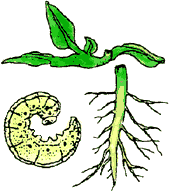Cutworms
- Cutworms are the caterpillar stage of Miller moths. They are about 1 inch (2.54 cm) long, brown-gray in color, and curl up when touched.
- They are nocturnal and are rarely seen in the daytime above the ground.

- If your tomato, cucumber, or bean seedlings are dying, gently uproot one of them. If it appears to have been severed at ground level, then cutworms have likely been feeding on them.
- The culprit can usually be found a few inches (approximately 5 cm) away from the affected seedling.
- To prevent cutworms from reaching the roots of your plants, create plant collars for each seedling and press them at least 1 inch (2.5 cm) into the soil.
- Till the garden in the fall and again in the spring to eliminate cutworm eggs and some cutworms.
- If you have chickens, allow them to roam in your garden. They enjoy eating cutworms.
Fascinating Facts!
- Cutworms can be found all over the world, and there are many different species. Some common species in North America include the black cutworm, the variegated cutworm, and the armyworm.
- Cutworms are nocturnal, which means they are most active at night. During the day, they hide in soil or other sheltered areas.
- Cutworms can cause a lot of damage to crops and gardens, especially in the early spring when plants are still small and vulnerable. They can eat through the stems of seedlings, causing them to wilt and die.
- Some species of cutworms are more than 2.5 cm (1 inch) long when fully grown! That's about the length of a paperclip.
- Cutworms are often controlled using natural predators like birds, ground beetles, and parasitic wasps. In some cases, insecticides may also be used to protect crops.
- Cutworms are not dangerous to humans or pets, and they do not bite or sting. However, they can be a nuisance if they are damaging your garden or crops!
bugs
caring
|





